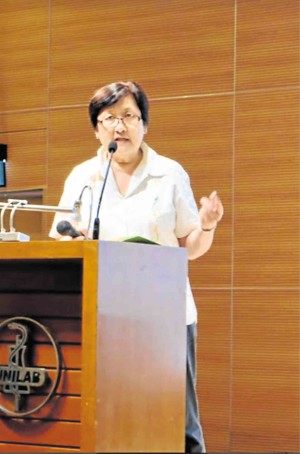Behold, Power of Pen
Does the Philippines have a national dish?
That was the inevitable thesis question posed at the last Power of Pen, a food writing workshop spearheaded by passionate foodie, Tetta Arroyo Tirona.
The theme for this year’s workshop, held at the Unilab Bayanihan Center last Saturday, was Regional Food Convergence.
The objective, in the words of the organizers, was to “bring together accomplished researchers and writers to address scholarly inquiries on the Filipino culinary history, unravel local cuisines and foodways from different regions of the country, and further our gastronomic quest through promoting local colors and sustainable agricultural plan.”
I had the pleasure of hosting and moderating the event and the Q&A for the speakers, with panelists Micky Fenix and Chef Myrna Segismundo, turned out to be a thorough discussion on the impact of regional cuisine in defining Filipino food.
Article continues after this advertisementSpeakers
Article continues after this advertisementThe roster of esteemed speakers included Amy Besa, author of Memories of Philippine Kitchens and the partner of Chef Romy Dorotan in the old Cendrillon in Soho and now Purple Yam in Brooklyn, with another Purple Yam in Besa’s ancestral home in Malate; Cora Alvina, author of “Batanes: A Delicate Balance,” founding executive director of Unilab’s Museo ng Kaalamang Katutubo and former president of the Metropolitan Museum of Manila; and Claude Tayag, known guru of Pampangeño food and author of Linamnam and Food Tour (who, by the way, has also just launched his food television show on the Lifestyle Channel).
Audiences were also first introduced to Edgie Politico, lexicographer and author of the first ever Philippine food dictionary, “Philippine Food, Cooking and Dining Dictionary”.
Specifically touching on Mindanaoan cuisine were Dr. Macario Tiu, 4-time Palanca awardee, professor at Ateneo de Davao and author of “Davao Cuisine: Recipes of the Ten Tribes of Davao City”; Mindanaoan chef Datu Shariff Pendatun III, winner of a Doreen Fernandez essay writing contest for his piece on the cuisine of Muslim Mindanao; and Chef Myke Tatung Sarthou, who zoned in on Mindanaoan cuisine in his talks for Madrid Fusion Manila 2016 and Madrid Fusion 2017 (in Spain).
Pastry chef Pixie Sevilla also joined the discussions, picking up from her grandmother’s book, “Kasaysayan ng Kaluto ng Bayan.” And French-Syrian Chef Xavier Btesh ended the workshop by discussing the similarities between French and Filipino cuisine.
No national cusine
The conclusion, in the words of Cora Alvina, was that we should not force the issue of having a national cuisine.
In the words of Micky Fenix, there is no such thing. And even Amy Besa, after eight years of exploring regional Philippine cuisine, finally agreed.
Instead, we are defined by the distinct flavors of each region.
We are the arayu and vunes of the Ivatan in Batanes, as Cora Alvina showed; and we are the bamboo dishes of the Lumads, as shared by Ateneo de Davao’s Dr. Macario Tiu.
Tayag noted the identifying flavors of each region, as he has observed in his travels: The
Ilocanos appreciate a range of bitter flavors; the Pampangeños and Tagalogs like sweet, sour, salty; the Bicolanos are distinct in their love for chili; while Visayans like notes that are sour. These all define us.
From north to south, Amy Besa emphasized, our cuisine is simply established by how chefs and cooks relate to the ingredients that are found on our land—“whatever grows in our environment and what we do to eat”— and how people interact with inherent flavors. Claude Tayag was more pragmatic about this. “We are what we are eating,” he said.
This includes canned sardines, instant noodles and even sweet fast food spaghetti.
Datu Shariff Pendatun III, who hails from Mindanao, went a step further: That if delineations were to be made based on cuisine, we can even “dissolve the notion that we have a nation”. Because, he explained, some of the flavors of Mindanao, specifically Moro cuisine, can also be found in neighboring Malaysia, and these flavors are very much unlike those found in Luzon. Although on the flipside, we have all the right to claim these flavors as ours.
Similarities
Over lunch on another day with Filipino food historian Felice Sta. Maria, she objected to this conclusion, saying we should have identified instead the similarities, the factors that unite our cuisines.
In fact there were some who did: Myrna Segismundo, co-author of the cookbook Kulinarya, said that Filipino cuisine is united by the “best practices” in the Filipino kitchen, i.e., methods of cooking common to most regions, e.g. inadobo, inasal, kinilaw. Cora Alvina noted things that are common throughout the nation: Kinilaw, rice, bananas, broiled fish, and sinigang “the super dish”.
But we are so diverse that it is really difficult to find a unifying, all-encompassing common thread. Maybe the common thread must simply be a shared desire to celebrate our differences!
Keep it alive
More than that, we must also all share a desire to preserve the various ingredients, dishes and cooking techniques that are truly ours, no matter how diverse. Methods and flavors passed down from our ancestors, methods that maybe existed even before we became Filipinas. Otherwise, Chef Tatung noted, some ingredients, dishes or cooking methods that could be classified as distinctly Filipino, would later only be a memory, something you only read about in books or look at in pictures in a museum, instead of something you can eat and experience everyday.
As we struggle to define what is commonly Filipino, we must also strive to identify and preserve our colorful culinary practices and cuisines from north to south so that generation after generation can continue to taste and enjoy the flavors of the Philippines, no matter how diverse. Anyway, there is that one thing that distinguishes the Filipino meal, in spite of regional differences: We all celebrate the Filipino spirit through food!
Amid the sweet, salty, bitter and sour, this is what binds us all. And as a Filipino, I am proud of that!
